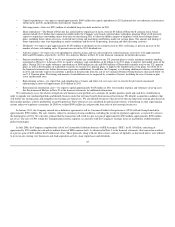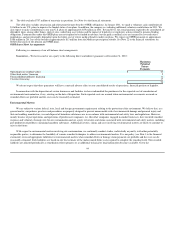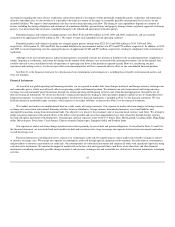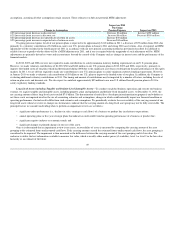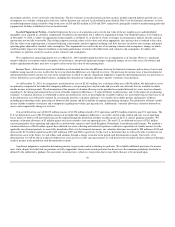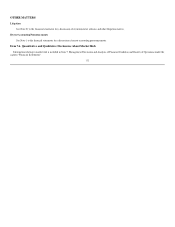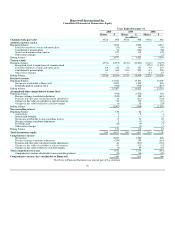Honeywell 2010 Annual Report Download - page 53
Download and view the complete annual report
Please find page 53 of the 2010 Honeywell annual report below. You can navigate through the pages in the report by either clicking on the pages listed below, or by using the keyword search tool below to find specific information within the annual report.
discounted cash flow, level 3 of the fair value hierarchy. The key estimates in our discounted cash flow analysis include expected industry growth rates, our
assumptions as to volume, selling prices and costs, and the discount rate selected. As described in more detail in Note 16 to the financial statements, we have
recorded impairment charges related to long-lived assets of $30 and $28 million in 2010 and 2009, respectively, principally related to manufacturing plant and
equipment in facilities scheduled to close or be downsized.
Goodwill Impairment Testing—Goodwill represents the excess of acquisition costs over the fair value of the net tangible assets and identifiable
intangible assets acquired in a business combination. Goodwill is not amortized, but is subject to impairment testing. Our Goodwill balance, $11.6 billion as
of December 31, 2010, is subject to impairment testing annually as of March 31, or whenever events or changes in circumstances indicate that the carrying
amount may not be fully recoverable. This testing compares carrying values to fair values and, when appropriate, the carrying value is reduced to fair value.
The fair value of our reporting units is estimated utilizing a discounted cash flow approach utilizing cash flow forecasts in our five year strategic and annual
operating plans adjusted for terminal value assumptions. This impairment test involves the use of accounting estimates and assumptions, changes in which
could materially impact our financial condition or operating performance if actual results differ from such estimates and assumptions. To address this
uncertainty we perform sensitivity analysis on key estimates and assumptions.
We completed our annual impairment test as of March 31, 2010 and determined that there was no impairment as of that date. However, significant
negative industry or economic trends, disruptions to our business, unexpected significant changes or planned changes in use of the assets, divestitures and
market capitalization declines may have a negative effect on the fair value of our reporting units.
Income Taxes—Deferred tax assets and liabilities are determined based on the difference between the financial statements and tax basis of assets and
liabilities using enacted tax rates in effect for the year in which the differences are expected to reverse. Our provision for income taxes is based on domestic
and international statutory income tax rates in the jurisdictions in which we operate. Significant judgment is required in determining income tax provisions as
well as deferred tax asset and liability balances, including the estimation of valuation allowances and the evaluation of tax positions.
As of December 31, 2010, we recognized a net deferred tax asset of $2,015 million, less a valuation allowance of $636 million. Net deferred tax assets
are primarily comprised of net deductible temporary differences, net operating loss carryforwards and tax credit carryforwards that are available to reduce
taxable income in future periods. The determination of the amount of valuation allowance to be provided on recorded deferred tax assets involves estimates
regarding (1) the timing and amount of the reversal of taxable temporary differences, (2) expected future taxable income, and (3) the impact of tax planning
strategies. A valuation allowance is established to offset any deferred tax assets if, based upon the available evidence it is more likely than not that some or all
of the deferred tax asset will not be realized. In assessing the need for a valuation allowance, we consider all available positive and negative evidence,
including past operating results, projections of future taxable income and the feasibility of ongoing tax planning strategies. The projections of future taxable
income include a number of estimates and assumptions regarding our volume, pricing and costs. Additionally, valuation allowances related to deferred tax
assets can be impacted by changes to tax laws.
Our net deferred tax asset of $2,015 million consists of $1,254 million related to U.S. operations and $761 million related to non-U.S. operations. The
U.S. net deferred tax asset of $1,254 million consists of net deductible temporary differences, tax credit carryforwards, federal and state tax net operating
losses which we believe will more likely than not be realized through the generation of future taxable income in the U.S. and tax planning strategies. We
maintain a valuation allowance of $3 million against such asset related to state net operating losses. The non-U.S. net deferred tax asset of $761 million
consists principally of net operating and capital loss carryforwards, mainly in the United Kingdom, Netherlands, Luxembourg and Germany. We maintain a
valuation allowance of $634 million against these deferred tax assets reflecting our historical experience and lower expectations of taxable income over the
applicable carryforward periods. As more fully described in Note 6 to the financial statements, our valuation allowance increased by $58 million in 2010 and
increased by $133 million and decreased by $45 million in 2009 and 2008, respectively. In the event we determine that we will not be able to realize our net
deferred tax assets in the future, we will reduce such amounts through a charge to income in the period such determination is made. Conversely, if we
determine that we will be able to realize net deferred tax assets in excess of the carrying amounts, we will decrease the recorded valuation allowance through a
credit to income in the period that such determination is made.
Significant judgment is required in determining income tax provisions and in evaluating tax positions. We establish additional provisions for income
taxes when, despite the belief that tax positions are fully supportable, there remain certain positions that do not meet the minimum probability threshold, as
defined by the authoritative guidance for uncertainty in income taxes, which is a tax position that is more likely than not to be sustained upon
50




